


BENJAMIN FRANKLIN 1706 -
xxxxxThe self-
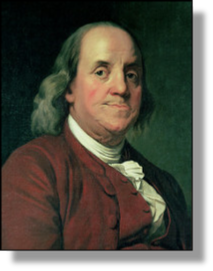 xxxxxThe distinguished American statesman Benjamin Franklin was his country's first ambassador to France, successfully managing to enlist French help in the War of American Independence. As we shall see, he also had a hand in drawing up his country's Declaration of Independence in 1776 (G3a) and played a prominent part in negotiating peace with Britain after the American colonies had won their struggle in 1783.
xxxxxThe distinguished American statesman Benjamin Franklin was his country's first ambassador to France, successfully managing to enlist French help in the War of American Independence. As we shall see, he also had a hand in drawing up his country's Declaration of Independence in 1776 (G3a) and played a prominent part in negotiating peace with Britain after the American colonies had won their struggle in 1783.
xxxxxWhilst his work as a politician in the formative years of the United States is known and acknowledged, he is perhaps best remembered today for his work as an amateur scientist. Mention his name, and most people conjure up a picture of him flying a kite in a thunderstorm. In this practical experiment, carried out in 1752, he attached a key to the kite's line and, by attracting electricity to it, proved the electrical nature of lightning. Based on this research, in 1754 he published his Experiments and Observations on Electricity, a work in which he introduced the terms negative and positive to identify the two charges. He then went on to invent the lightning conductor and within twenty years over 400 houses in 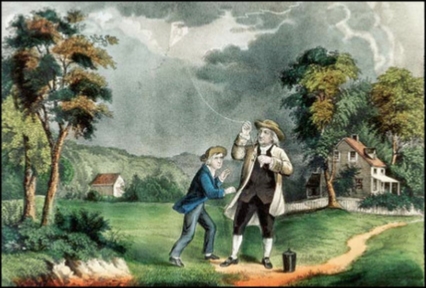 Philadelphia had been fitted with one. In recognition of his contribution to experimental science he later received honorary degrees from both the universities of Saint Andrews and Oxford, and was admitted to the Royal Academy and the French Academy of Sciences.
Philadelphia had been fitted with one. In recognition of his contribution to experimental science he later received honorary degrees from both the universities of Saint Andrews and Oxford, and was admitted to the Royal Academy and the French Academy of Sciences.
xxxxxHe also made a number of other useful inventions, including bifocal lenses, an efficient heating stove, an odometer for measuring the distance travelled by a cart, and a much improved glass harmonica (for which Mozart composed two pieces!). Such was the width of his interests and the strength of his civic duty, that in 1727 he formed a discussion group called the Junto (or Leather-
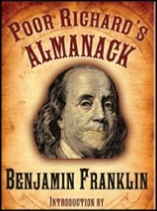 xxxxxFranklin was born in Boston, and was the fifteenth of seventeen children. He had only two years of schooling, but educated himself while a young man. He became a printer's apprentice at the age of 12, and six years later visited England, where he worked as a printer for 18 months to complete his training. On returning to Philadelphia, he set up his own business, and in 1729 bought the Pennsylvania Gazette, quickly improving its content and circulation. Among the number of successful works he published was Poor Richard's Almanac, a witty, common sense guide to successful living. First issued in 1733 under the pen-
xxxxxFranklin was born in Boston, and was the fifteenth of seventeen children. He had only two years of schooling, but educated himself while a young man. He became a printer's apprentice at the age of 12, and six years later visited England, where he worked as a printer for 18 months to complete his training. On returning to Philadelphia, he set up his own business, and in 1729 bought the Pennsylvania Gazette, quickly improving its content and circulation. Among the number of successful works he published was Poor Richard's Almanac, a witty, common sense guide to successful living. First issued in 1733 under the pen-
xxxxxHis interest in politics began in 1750, when he was elected a member of the Pennsylvania Assembly. In 1753 he was appointed deputy postmaster general for the colonies, and did a great deal to extend and speed up the mail service. The following year he attended the Albany Congress on the future of the colonies. The Plan of Union he then put forward, which proposed partial self-
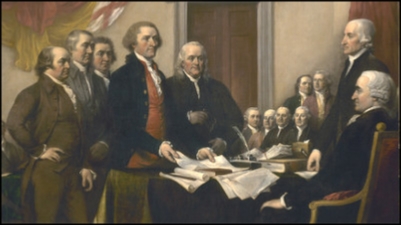 xxxxxAfter open warfare had broken out he took a leading part in the drafting of the American Declaration of Independence. The painting on the left (a detail), shows the Declaration being submitted to the Continental Congress in June 1776 (Franklin centre). Later that year he was sent to France, where, as the popular American ambassador, he proved successful in gaining not only vital French aid for the revolution, but also France's entry into the war in February 1778 -
xxxxxAfter open warfare had broken out he took a leading part in the drafting of the American Declaration of Independence. The painting on the left (a detail), shows the Declaration being submitted to the Continental Congress in June 1776 (Franklin centre). Later that year he was sent to France, where, as the popular American ambassador, he proved successful in gaining not only vital French aid for the revolution, but also France's entry into the war in February 1778 -
xxxxxHe was not without faults (errata), as his autobiography of 1788 candidly admits, but it must be said that he was a man of outstanding character and talent. Industrious, tolerant, resolute, and with a good helping of common sense, he showed great skill as a civil administrator and diplomat and -
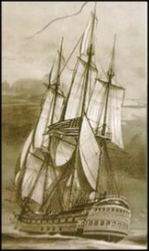
xxxxxIncidentally, as might be expected of a printer and publisher, Franklin wrote his own epitaph. It expressed the hope that he would appear again in a "new and more beautiful edition, corrected and amended by the Author"! ......
xxxxx...... During his time as ambassador in France he assisted, among others, the American naval captain John Paul Jones, then using France as a base for his attacks on British coastal shipping. When the French gave Jones a merchantman to carry on his exploits, he named it Bonhomme Richard (Simple Richard) after Franklin's Poor Richard's Almanac. ……
xxxxx…… Andxwhen serving as Postmaster General to the American colonies, this remarkable man plotted the course of the Gulf Stream to show why mail travelling from Europe to America took longer than mail travelling the other way. The following year, 1770, working with Timothy Folger (c1732-
Acknowledgements
Franklin: by the English painter Joseph Wright of Derby (1734-
G2-


